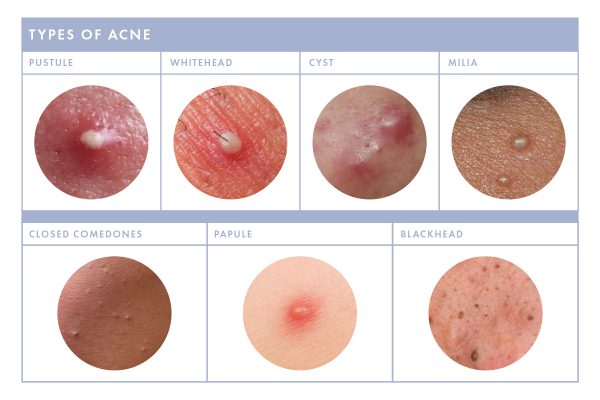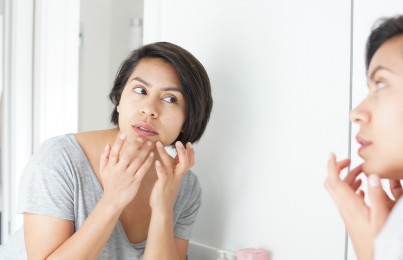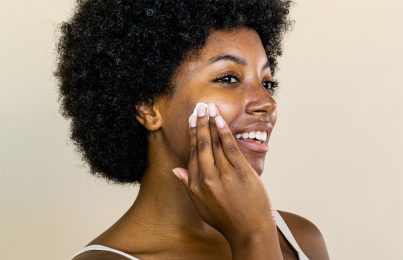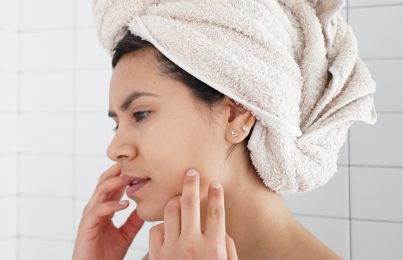Updated 8/5/18. All types of acne and blemishes are not equal. Whiteheads are a type of small blemish that comes and goes fairly quickly. In this post, I’ll first explain exactly what whiteheads are (and are not!) and then will go into how to treat them. With my expert tips, your skin can be clear and bump-free in no time.
Whiteheads are best described as infected, white bumps on the face but are not milia.
There is a lot of confusion as to what “whiteheads” really are. Whiteheads are small blemishes caused by Propionibacterium acnes (P. acnes) bacteria. They don’t have much redness or pain when touched, unlike a papule, pustule, or cyst. When they begin, the infection comes to the surface fairly quickly and forms a white-colored head. When squeezed, the pus pops out easily (usually on the first try) and not much scarring or redness is left behind. Of all the types of blemishes where the infection works its way to the surface of the skin, whiteheads are the easiest to deal with because the life cycle is fast.
It’s important to know that whiteheads that look like white bumps on the face are not milia. Milia, as you can see in the above photo is considered to be a non-inflammatory lesion. Meaning, they are like hard whiteheads on the face but aren’t actually whiteheads. Milia is often found on the upper cheeks or around the eyes and needs to be removed by a dermatologist or skilled esthetician.
Whiteheads are different from pustules.
Additionally, a lot of people get whiteheads confused with regular blemishes. In the photo above, you might think a whitehead looks a lot like a pustule. There are similarities in that they both have visible pus on the surface. However, whiteheads have less infection around them so the raised part of the face is usually just the whitehead. Versus with a pustule, you can see that not only is the whitehead protruding from the skin to make a bump but also all of the area around it, too. Simply put, a whitehead is a small bump that can be easily popped and removed (oftentimes without any blood coming along with it) and a pustule is a larger, raised bump that will be painful and when squeezed can ooze with blood.
Common causes of whiteheads:
Oily skin
Those with oily skin are going to be more likely to get whiteheads since the underlying cause of whiteheads comes from oil. (Oil breeds bacteria and bacteria leads to whiteheads.)
How to prevent whiteheads: Just like with any clogged pores, bumps, and blemishes, these all stem from having oily skin.
Exfoliating products
Sometimes if you’re new to using exfoliating acids (products with glycolic, lactic, and salicylic acids), the skin can get some whiteheads as it rearranges your skin’s cell turnover process. This can be called a “purging” process as trapped oils are being released due to the removal of surface dead skin cell buildup. Generally, this is short-lived and will go away as your skin gets used to regular exfoliation.
How to prevent whiteheads: When introducing exfoliating acids, facial scrubs, or at-home skin peels, take it slowly. If a peel says to leave it on for 10 minutes, only leave it on for two minutes. When using a facial scrub, massage it across the skin without applying much pressure so as not to aggravate the skin. If an exfoliating acid says to use it every night, start with using it just once a week. It’s all about baby steps with exfoliants until your skin gets used to them.
Hair removal such as waxing or threading
These methods of hair removal can cause the skin to purge into whiteheads so a lot of people just learn to accept it because they have no other choices for removing the hair.
How to prevent whiteheads: After removing the hair, immediately apply ice for ten minutes and then follow with a light layer of cortisone cream. This combination may help calm the inflammation that leads to whiteheads.
Moisturizer
Some moisturizers, even if it doesn’t feel particularly heavy, can have a high concentration of oils and emollients. This may block some of the pores and lead to the production of whiteheads.
How to prevent whiteheads: You always want to use a moisturizer for your skin type. (Skin types #1, #2, #3 and #4 are skin types that produce oil.) If you’re feeling tight or dry and need additional moisture, you’re better off applying a skin serum underneath to give a boost of hydration.
Liquid foundations
For some combination and oily skin types, the ingredients used in liquid foundation makeup can create a blockage in the pore-lining which leads to an infection. This can cause whiteheads to appear on the face.
How to prevent whiteheads: Switch to a powder foundation or try a different liquid foundation. A lot of times, it’s just trial and error.
Makeup primers
These “base coats” for making pores appear invisible under foundation makeup are really popular now but can act similar to liquid foundations by blocking the pores.
How to prevent whiteheads: As much as possible, try to limit their use to special occasions. Primers can contribute not only to whiteheads but also to clogged pores, bumps which lead to a bumpy texture for the skin.
Heat
Heat, such as from being outside on a hot summer day, increases sudden oil production. When the pore has too much oil trying to get through the opening, whiteheads can start up.
How to prevent whiteheads: Try to cleanse your skin as soon as possible once you get indoors to remove way any heat-induced oil. Be sure to apply toner and moisturizer afterward as you never want to leave your skin bare after cleansing. This can quickly lead to dehydration which can put your skin out of a healthy balance.
How to know if a face product is the cause of your whiteheads?
If you just started using a new product and within the first few days, you suddenly get a small cluster of 3-4 whiteheads in one area. This might be an indication that it was from something new that you applied topically. Why do whiteheads sometime appear in a certain area when you applied a new product to the entire face? More than likely, it’s because there already was some sort of blockage or disruption of oil flowing through the pore lining that erupted when something new was introduced.
How to get rid of whiteheads under the skin.
Step 1: After cleansing the skin, gently squeeze out the infection.
Once whiteheads appear on the very surface of the skin, they are very easy to pop out. Simply gently squeeze out the infection with your fingers wrapped in tissue. While some experts may cringe at the thought of me instructing people to squeeze at their faces, this can be very safe if done correctly. And in reality, no one wants to walk around with have whiteheads on their skin, right?
Step 2: After removal, apply a non-drying, antibacterial mask to disinfect the pores.
The skin will greatly benefit from using a gentle antibacterial mask that will get into the pores to ensure they stay clean. I recommend Rapid Response Detox Masque to all of my clients prone to whiteheads, clogged pores, and bumps. It uses a popular ingredient called salicylic acid which works its way into the pores lining to prevent oil blockage. Additionally, it offers other soothing benefits for calming and clearing the skin. Note: Clay masks aren’t very effective for doing this.
In summary…
Whiteheads: white bumps on the face that are not milia but rather an infected type of blemish that secretes white pus up and out through the surface of the skin. I’m often asked about how to get rid of whiteheads under the skin that appear often? A mask like Rapid Response Detox Masque can be used as often as every day to help prevent whiteheads from appearing in the first place—no matter what the cause.
Celebrity Esthetician & Skincare Expert
As an esthetician trained in cosmetic chemistry, Renée Rouleau has spent 30 years researching skin, educating her audience, and building an award-winning line of products. Her hands-on experience as an esthetician and trusted skin care expert has created a real-world solution — products that are formulated for nine different types of skin so your face will get exactly what it needs to look and feel its best. Trusted by celebrities, editors, bloggers, and skincare obsessives around the globe, her vast real-world knowledge and constant research are why Marie Claire calls her “the most passionate skin practitioner we know.”





Comments:
Hi I am so desperate for hwlpno have been to dermatoligist and esthetician my skin has always been pretty good with occasional breakouts cant eat chocolate and have to wash face with distilled water only but in novemeber my doctor prescibed me one pill for yeast infection and simce then my body and face and system has been out of whack it caused blisters then caused me to become sensitive and reactive to wverything my entore face rountine was causing break outs my moisturizers ect so now ive jist been washingbmy face and using no moisturizer just so i dont breakout but my skin is so dry and then gets oily because of it towards the end of the day i had to stop exfoliating with my honey sugar scrub so my skin is not smooth and getting clogged I qoke up to a white head on thw side of my nose now I’m assuminh from not exfoliatingband mosturizing but I’m lost on what to try I feel like no one can help me get back to healthy skin with all my reactions.
Posted By: Nikki |
I’m sorry to hear that, I would talk to the doctor who prescribed the medication for your yeast infection. Since this seems to be a point in time where your skin took a turn for the worse it may be helpful to discuss the condition and the medication you were using around that time with your doctor.
Posted By: Ella Stevenson |
I’ve been suffering with this severe acne and cyst bumps that will not go away , and more come . I’m starting o get depressed .
Posted By: Jenna |
Here’s more tips to read for reducing acne and breakouts.
Posted By: Renée Rouleau |
Hi,
I have skin type 3 and get pustules on my cheeks that leave post acne marks and I also have milia on my cheeks and jawline. i do leave the milia alone but one by one they get inflamed leaving more acne marks behind. I just started using your BHA/AHA cleanser, the BHA clarifying serum and skin recovery lotion about 2 weeks ago, when should I start seeing results usually? I know it takes time. Also should I be using any other products to heal up my acne marks or new pimples coming in?
Posted By: Deanna |
It sounds to me as though you need to get a deep pore cleansing facial to clear out blocked pores. Closed comedones (what you’re referring to as milia) can turn into blemishes, as you have discovered, so clearing those out would be super helpful. The products you are using will then be even more effective by getting into the pores and helping them to stay clean, so I would highly suggest you find someone to do a lot of extractions on your skin. As for the routine, while you did get some great products, I would suggest you try to invest in other products for skin type 3. Essentially, the more you use, the more your skin will get the full benefit. Our acne spot treatments are amazing, too. (Like the Anti Cyst Treatment dabbed onto inflamed blemishes). As for the few products you have, it’s hard to say when you should see results but I’d say give it a good 3-4 weeks but again, it’s hard for me to say without seeing your skin.
Posted By: Renée Rouleau |
Hello, I have started having a bad problem with red skin (rosacea) It comes and goes ,but is very embarrassing and makes me want to wear foundation all the time to cover it. I have tried metronidazole gel and oracea orally,neither help. I have read that it is due to dry skin, so I use a moisturizer which then makes my skin oily and I get tiny white bumps all over. My forehead gets very oily and makes my hair oily and I get milia there also. Please advise, Thank you (I am 47 yrs.old)
Posted By: celia |
It sounds like you’re not using the right type of moisturizer for your skin type if you’re getting white bumps all over. It’s clearly too pore-clogging for you. But yes, rosacea can benefit from repairing your skin’s moisture barrier and using the correct home care regimen will improve this. Take this Skin Type Quiz and get products recommended. Sounds to me as though you are a skin type #5 but take the quiz to make sure.
Posted By: Renée Rouleau |
Yes hello what is the difference between skin type 2 and skin type 4?
Posted By: Vane |
You can look at all nine skin types here and see the differences. (Click into each.) The main difference between skin type 2 and 4 is that 2 doesn’t get that much breakouts and is concerned about aging, so it might be someone who is in their late 20 or early 30s and beyond whereas usually skin type 4 is someone under 30 where they are still getting breakouts.
Posted By: Renée Rouleau |
Yes hello will the AHA smoothing serum help with blackheads/whiteheads around the nose? And also under the lip and chin? Will it remove clogged pores along the hair line/ cheekbones? Or do I need something stronger such as the BHA serum? And on my mid forehead above the brows I also get little bumps that are whitehead heads and then become pustules?
Posted By: Clarissa |
It sounds like the BHA Clarifying Serum would be better for you since you get a lot of clogged pores. I would first recommend that you get a deep pore cleansing facial from an esthetician to clean those out and then the BHA serum will work deeper in the skin to keep it looking clear.
Posted By: Renée Rouleau |
Even though I’m a skin type 5?
Posted By: Clarissa |
The BHA serum will work on skin type 5? I have clogged pores on the sides of my cheeks and then turn into pimples I’ve never had this problem before! Really want to get rid of them it’s very frustrating!
Posted By: Clarissa |
I would recommend the AHA Smoothing Serum 10% for skin type #5. Because it is exfoliating the skin, it will help clogged pores. You’ll also want to consider getting a deep pore cleansing facial.
Posted By: Renée Rouleau |
Yes I have a question about my skin type I don’t know if I’m a skin type 4 or 5? Can you help me?
Because I do have a small spot of redness on one cheek but I just breakout on the sides where my cheekbones are they are tiny bumps clogged pores that turn to red bumps pimples i don’t know why but nothing seems to work or get rid of them? I have normal skin and I do get oily on my t zone if that helps!
Posted By: Vanessa |
Ok but I can use all the products from the complete selection on skin type 5 correct except the advanced retinol?
Posted By: Vanessa |
Yes, definitely.
Posted By: Renée Rouleau |
Thank you so much really appreciate your feedback!
Posted By: Vanessa |
I am 19 years old and I just recently got these tiny little bumps along both my cheek bones and mid forehead I never had this issue with clogged pores. I have normal sensitive skin with redness on one cheek. I tend to get oily in summer and dry, tight in winter. I really want to get rid of it and have nice smooth skin with no visible redness. What should I do to prevent these tiny bumps any suggestions?
Posted By: Vanessa |
It would be very helpful to start exfoliating regularly with either a facial scrub (used 3 times a week) and/or an exfoliating acid serum like one of these. Take my Skin Type Quiz here to get products recommended.
Posted By: Renée Rouleau |
Yes I already did I’m a skin type 5. Should I use the AHA smoothing serum and the advanced retinol serum? Or the BHA clarifying serum?
Posted By: Vanessa |
If you’re a skin type #5, then go with the AHA Smoothing Serum 10%. The Advanced Resurfacing Serum is for anti-aging, not surface exfoliation, but it’s too early to use so don’t get that. Use the AHA Serum three nights on, three nights off, alternating with the Soothing Relief Serum. All are oil-free.
Posted By: Renée Rouleau |
Ok but I can use everything in the complete selection correct except the advanced retinol?
Posted By: Vanessa |